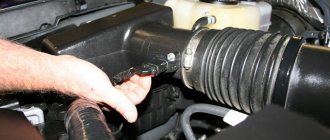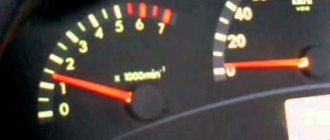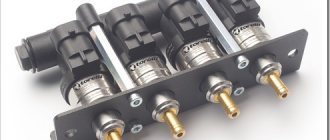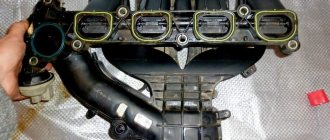The five-door hatchback VAZ 2114 is a restyled model of the famous “nine”, which rolled off the assembly line of the car plant from 2003 to 2013. At various times, the manufacturer installed on the car power plants with carburetor or distributed fuel injection (injector) of its own making, and since 2007 the car has been equipped with an electronic engine control system. Note that all these engines have one common and very significant drawback - when they switch to idle mode, their crankshaft speed suddenly begins to “float”.
Idle mode
Idle speed is the operating mode of a car engine with the gear in neutral. It is characterized by minimal engine load and low fuel consumption.
Idle mode is used:
- for delivering motor oil from the engine crankcase to friction units after a long period of parking the vehicle;
- to warm up the power unit in the cold season;
- in cases where turning off the motor is impossible or undesirable.
During normal engine operation, the crankshaft speed is idling at 2000 rpm. gradually decrease to 800, then maintaining at this level. However, it also happens that the power plant, when switching to this mode, operates unstably - it randomly changes the speed in the range of 500–1500 rpm, “chokes” and stalls. This tells us: a failure has occurred in the engine control system, the causes of which must be diagnosed and eliminated as soon as possible.
The movement of the arrow of the device shows the change in the number of engine revolutions
Determining the specific cause of the malfunction is not easy, but it cannot be ignored - this can lead to critical engine failure and the need for expensive repair work. In addition, driving a car with an engine that is unstable at idle speed distracts the driver's attention. He has to constantly monitor changes in the speed and keep his foot on the gas pedal, preventing the engine from stalling when braking or stopping briefly.
How does this happen
If the car is running normally, all you need to do is start it and wait until the engine warms up to the optimal temperature. The tachometer indicator at this moment is at 2-2.5 thousand rpm, and then gradually drops to about 800 rpm as the power unit warms up.
But when there are problems, the idle speed jumps and changes sharply. The range of revolutions difference on the tachometer can be significant, up to 1.5 thousand revolutions. The car seems to live its own life. After some time, this phenomenon stops. But the next time the ignition is turned on, everything repeats.
Causes of malfunction
Among the reasons leading to improper engine operation in idle mode are problems with sensors that transmit information to the electronic control unit . These include sensor malfunctions:
- idle speed controller (IAC);
- mass air flow (MAF);
- crankshaft position (CPCV);
- throttle valve position;
- vehicle speed (VSA).
The appearance of floating crankshaft speeds also causes:
- malfunction of the idle speed solenoid valve;
- dirty air filter and spark plugs;
- damage to high-voltage wires;
- wear of gaskets and plugs at the junction of the intake manifold with the cylinders;
- malfunction of the EGR valve, which regulates exhaust gas emissions.
Checking spark plugs and ignition system
If you have not found which sensor is responsible for the floating engine speed, you should pay attention to the condition of the spark plugs and high-voltage spark plug wires. The cause of the malfunction may be:
- carbon deposits and contamination of spark plugs. Cleaning can only provide short-term improvement. It is better to replace spark plugs with new ones;
- damage to wires. High-voltage spark plug wires are checked visually for damage (at night, if the insulation is damaged, a spark is noticeable when the engine is running).
- bad contact. You need to check the condition of the contact of the wires and spark plugs (disconnect and reconnect the spark plugs);
Subscribe to our feeds on social networks such as Facebook, Vkontakte, Instagram, Twitter and Telegram: all the most interesting automotive events collected in one place.
Methods for eliminating floating engine speeds
When starting to find and eliminate the reasons that cause unstable operation of the engine in idle mode, you first need to check:
- Condition of the air filter and spark plugs. If they become critically dirty, they need to be replaced.
- Integrity of insulation of high-voltage wires. If damage is found, they must be replaced.
It is recommended to make sure that there is no suction at the junction of the intake manifold with the engine cylinders. To do this, with the engine running, you need to sequentially spray all joints at the joints with carburetor cleaner or other flammable liquid. If atmospheric air enters there, the car engine jerks sharply, which is why, if a damaged gasket or plug is detected, the element is replaced.
Checking the tightness of the intake manifold (video guide)
Let's consider the remaining elements of the car, the malfunction of which can affect the smooth operation of the VAZ 2114 engine in idle mode.
Solenoid valve diagnostics
Cars with engines equipped with a carburetor are equipped with idle speed solenoid valves. Devices are checked as follows:
- Disconnect the power cord.
- Start the engine to warm up.
- Connect the wire. If a clear click is not heard, the part must be replaced.
Attention! To fully ensure that the valve is working properly, be sure to clean the nozzle and repeat the test.
Adjusting the idle speed on a carburetor engine (with video)
Note that the main reason for the appearance of floating idle speed in engines of this type is the incorrect operation of the carburetor. The device is adjusted by rotating the fuel quality and quantity screws.
Is the EGR system on the injector working?
"Floating" speed can be caused by jamming of the exhaust gas recirculation (EGR) valve, which is installed in the exhaust manifold. It is necessary to periodically remove dirt from the valve seat and its seat using a carburetor cleaning aerosol, avoiding liquid getting on the sensor diaphragm.
Keep the valve seat clean
Attention! If cleaning the unit does not give a positive result, the device must be replaced.
Is the idle air control valve working correctly?
The IAC is checked by measuring the electrical resistance at the contacts - to diagnose the device you will need a tester (multimeter) set to the “ohmmeter” operating mode. To check the details:
- Let's turn off the ignition.
- Disconnect the connection block.
- Let's measure the resistance on contacts A - B and C - D of the device. The optimal readings of the device vary from 40 to 80 ohms.
- Let's repeat the measurements with contacts B - C and A - D. In this case, the multimeter should show “infinity” or an open circuit.
Any violation of the normal resistance values means a malfunction of the regulator. IAC failure is a common cause of floating engine speed at idle, and if a malfunction is detected, the device must be replaced. Before you begin dismantling the part, you must disconnect the negative wire from the battery. After installation, the new IAC is calibrated - the removed terminal is returned to its place, the ignition is turned on and after 5-10 seconds (there is no need to start the engine).
IAC failure is a common cause of floating engine speeds.
Attention! If the battery is not disconnected before dismantling the device, the electronic control unit will not calibrate the IAC.
Serviceability of the mass air flow sensor
To diagnose the mass air flow sensor, you need to switch the tester operating mode to “voltmeter” (20 V). We check the part by following these steps:
- Let's turn off the engine and turn on the ignition.
- Let's measure the voltage at the connection connector between the contacts of the green and yellow wires. The multimeter reading should be in the range of 0.99 - 1.02 V.
The device can be cleaned by “blowing” with a carburetor cleaning aerosol
Attention! The device can be dismantled and cleaned using a carburetor aerosol, but this does not always help. In the event of a critical component failure, it will have to be replaced.
Video: Checking the mass air flow sensor
Cleanliness of the damper assembly
The throttle valve assembly is diagnosed by visual inspection for contamination. Clean the part with cotton swabs and a toothbrush moistened with a cleaning solution. For ease of work, the device is dismantled. After cleaning, it is recommended to blow out all channels and pipes of the unit with compressed air using a tire inflator.
To clean the part, it must be dismantled
Attention! It is recommended that the channel responsible for removing gases from the crankcase be completely filled with a cleaning solution before purging - the diameter of the element is very small and there is no other way to access it.
Video: How to clean the throttle body
Is it possible to diagnose DPKV and DSA?
A breakdown of the DPKV and DSA (Hall sensor) is indicated by the Check Engine indicator that lights up on the car’s dashboard. Testing these devices is only possible using special instruments (oscilloscopes). You can first check the integrity of the wiring; if it is broken, the damage should be repaired.
- The DPKV sensor is installed on a bracket located in close proximity to the generator drive pulley.
- The DSA is located on the speedometer drive mechanism of the gearbox.
For a more detailed introduction to methods for detecting faults associated with engine malfunction in idle mode, it is recommended to watch the following video.
Conclusion
Many car enthusiasts do not know the reasons for the high idle speed effect, much less how to eliminate it. So, of course, experts and car mechanics recommend contacting a car service straight away, but our man won’t stop until he tries it himself.
There are many reasons for the effect of increased speed, from faulty sensors to errors in the electronic control unit. You can also fix the problem at home, which is what owners of VAZs and other domestic cars do. But owners of foreign cars will have to contact a car service center, where repairs can amount to a considerable amount.
Good afternoon. Help with advice. In general, in the cold weather the check light came on. At first the speed just started to jump a little. Now the idle is kept at 1.5k almost all the time. And if you press the clutch at speed, it increases up to 3k. From time to time the check does not disappear for long, but the problem does not go away, you have to revise the throttle all the time so that the speed drops. Also, all this is accompanied by increased gasoline consumption. Unfortunately, there is no BC, and I consider it a waste of money to go for diagnostics; they rarely help anyone significantly.
After reading a lot of posts about this, I realized that it was necessary to sin on one of the following: IAC, DMRV, DPS or lambda probe.
But I changed the pxx recently, when the speed, on the contrary, dropped to 0.5, plus if there are problems with the pxx, the check light does not light up.
The main task of the idle speed system (mode) is to maintain engine speed at a minimum level, ensuring complete combustion of the fuel-air mixture in the cylinders. The number of idle speeds on different engines may vary, the range is 700-950 rpm. Excessively low tachometer readings lead to unstable engine operation, which may stall. On the other hand, high engine speeds at idle are fraught with excessive fuel consumption and more toxic exhaust. Below we discuss the main reasons for the increased and unstable crankshaft speed at idle for a carburetor and injection engine.
Sources
- https://carfrance.ru/pochemu-vaz-2114-plavayut-oboroty-na-xolostom-xodu/
- https://luxvaz.ru/vaz-2114/135-plavayut-oboroty-na-holostom-hodu.html
- https://mashinaa.ru/avtovaz/vaz-2114/6444-plavajut-oboroty-na-holostom-hodu-vaz-2114-inzhektor-prichiny.html
- https://remontvazov.com/plavayut-oboroty-na-holostom-hodu-vaz-2114-inzhektor
- https://FB.ru/article/146420/plavayut-oborotyi-na-vaz—-prichinyi-i-metodyi-ustraneniya
- https://provaz2114.ru/dvigatel/plavayut-oboroty-na-holostom-hodu-vaz-2114-prichiny.html
- https://pol-z.ru/plavayut-oborotyi-na-holostom-hodu-vaz/
- https://prometey96.ru/ustrojstvo/plavayut-oboroty-vaz-2114.html
Cleanliness of the damper assembly
The throttle valve assembly is diagnosed by visual inspection for contamination. Clean the part with cotton swabs and a toothbrush moistened with a cleaning solution. For ease of work, the device is dismantled. After cleaning, it is recommended to blow out all channels and pipes of the unit with compressed air using a tire inflator.
To clean the part, it must be dismantled.
Attention! It is recommended that the channel responsible for removing gases from the crankcase be completely filled with a cleaning solution before purging - the diameter of the element is very small and there is no other way to access it.
TPS is out of order
The throttle position sensor is another suspect. The symptoms are similar to IAC, except that when moving away smoothly the car will do so jerkily. The sensor is also located on the throttle in the area where the throttle cable is connected.
The test can be done using a multimeter. If TPS is installed on the car, then open the throttle and watch the tester readings, they should change smoothly. If removed, then use a screwdriver and also look at the readings.
Solenoid valve diagnostics
Cars with engines equipped with a carburetor are equipped with idle speed solenoid valves. Devices are checked as follows:
- Disconnect the power cord.
- Start the engine to warm up.
- Connect the wire. If a clear click is not heard, the part must be replaced.
Attention! To fully ensure that the valve is working properly, be sure to clean the nozzle and repeat the test.
[custom_ads_shortcode2]
Why does the speed fluctuate on the VAZ-2115 injector?
Often, owners of a VAZ-2115 with an injection engine have to deal with a situation where the idle speed begins to float. At first glance, this malfunction is minor. However, first of all, it simply irritates the driver, and besides, a car parked at an intersection in “neutral” can simply stall and thereby provoke an emergency situation. We should also not forget about increased fuel consumption. After all, in order not to stall, you need to constantly “play” with the accelerator, keeping the speed at the desired level. So it is best to take this problem seriously.
Serviceability of the mass air flow sensor
To diagnose the mass air flow sensor, you need to switch the tester operating mode to “voltmeter” (20 V). We check the part by following these steps:
- Let's turn off the engine and turn on the ignition.
- Let's measure the voltage at the connection connector between the contacts of the green and yellow wires. The multimeter reading should be in the range of 0.99 - 1.02 V.
The device can be cleaned by “blowing” it with a carburetor cleaning aerosol.
Attention! The device can be dismantled and cleaned using a carburetor aerosol, but this does not always help. In the event of a critical component failure, it will have to be replaced.
[custom_ads_shortcode3]
Visiting a car service center
In a situation where you specifically do not have enough experience in car maintenance, there is a fairly high probability of aggravating the problem by unqualified intervention in the operation of various on-board systems.
It is important to objectively assess your own capabilities, and if you don’t have faith in yourself, then it is better to entrust the repairs to specialists. In a situation where it turns out that the problem is not particularly serious, they won’t take much money from you
But in any case, you will be able to avoid many of the troubles associated with unqualified attempts to repair the vehicle.
Mechanical problems
First, you should check the throttle cable. Quite often it jams, and the pedal “sticks” when the driver has already removed his foot and the speed has not decreased. This may be due to the following problems:
- Corrosion of the cable
. At the same time, it simply gets stuck in the shirt; - Lubrication
. Sometimes drivers, in an effort to improve the operation of the unit, lubricate the cable; in winter, the lubricant freezes, which causes jamming;
- Unsuccessful repair
. In some cases, after repairs, car owners incorrectly position the cable, resulting in problems.
Therefore, be sure to check the condition of the cable. See how it moves and replace it if necessary.
Air flow sensor
If the IAC turns out to be serviceable, then you should check the air flow sensor. To do this, you will also need a multimeter set to voltage measurement mode (in the range of up to 20 volts).
Measurements are carried out as follows:
- turn off the engine and turn on the ignition;
- measure the voltage at the sockets used to connect the yellow and green wires;
- if the voltage value is in the range of 0.98 - 1.02 volts, then the sensor is working. If not, then action should be taken.
To begin with, you can try to clean the sensor by blowing it with a composition for cleaning carburetors (in the form of an aerosol), although this does not always help. If after purging the voltage readings return to normal, then the “repair” was successful; if not, then the sensor will have to be replaced with a new, similar one.











